
|  |

|  |
e-mail: khokar1960@gmail.com Vive la Republique! January 28, 2019 So, the new year began in right earnest where I was born, Baroda. The Dept of Dance at MSU was the happy venue for many dance academicians to meet and greet; eat and interact. Small town India is what big towns once were: happy, happening and healthy! Distances are easy to commute; people easy to bond with. Guru Dr. Jagdish Gangani, the current head of the dance department outdid himself by hosting and organizing the best ever gathering, an international one, on 4th and 5th January, where dancers and researchers came from all over - from as far as Trinidad and Tobago and Mauritius; from closer home in Sangli or Telangana. Biggest number of participants came from Punjab. They were happiest in the assembly, perhaps reflecting mind over matter. Many delegates felt more time was spent in eating than on seminar. Many participants were disappointed too, since venues were three, so audience got split but how else to accommodate so many applicants? In my keynote address, I shared how Baroda Dance Dept. had started. It was a trip down memory lane. How the first teachers were found and brought by my father Prof. Mohan Khokar, the founder-head (1950-62), who realized that if traditional knowledge was not amalgamated then it will be lost and just because some didn't have a school or college degree, it didn't mean they were any less qualified. Thus, were brought in gharana talents like Kubernath Tanjorkar for Bharatanatyam and Sundarlal Gangani from Meerut (whose sons are the talented brothers Harish and Jagdish Gangani), with first generation of students like Nargis Katpitia, Pratibha Pandit, Laxmi Valrani ...I shared historical perspective on dance teaching at Baroda Dance Dept, India's first university to offer dance at college level. From there to today has indeed been a long journey. The two day seminar had its high points: excellent talks by Prof. Deepak Kannal. Next day Prof. Mahesh Champaklal's lecture on Natyashastra was the best I had heard on the subject anywhere in India. Next best was by Padmini Shreedhar from Bangalore. But there were many that lacked content or concept, like the yoga master showing photos of dance and dancers! In the evening, the dept. showcased its best foot forward and in Kathak, with live music to boot, Durgesh delighted with his tayari and senior talent Preeti Sathe, with her layakari. Credit for both goes to their guru Dr. Jagdish Gangani. Bharatanatyam by Smruti Vaghela was exquisite. Here is someone who is pleasing on stage and imbibed best practices of Padma Subrahmanyam style, heavily infused with karanas. It sat well on Smruti Vaghela who was in fine fettle and form. The same cannot be said of other Bharatanatyam teachers of the dance department, who ought to think before getting on stage to perform. Body is the instrument, the tool of dance. Does a musician get on stage with untuned instruments? The group presented did well in the small space and episodes from Krishna Leela were very well articulated with excellent group work. I had the privilege and honor of sitting next to the Chancellor, who is also the Maharani of Baroda and we exchanged many memories and my musings of past dance links. Her husband, the Maharaja Ranjitsinh Gaekwad had released our Gujarat issue of attenDance 15 years ago! 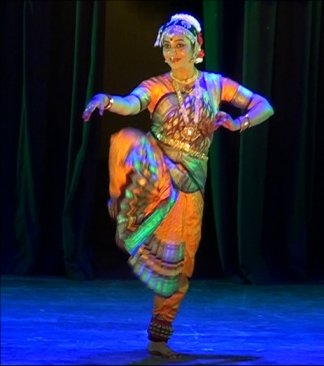 Smruti Vaghela 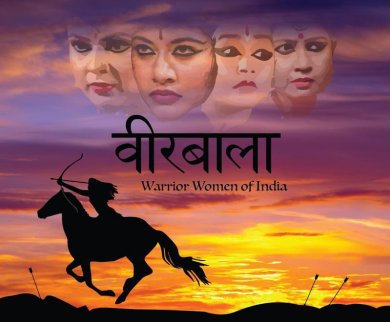 Veerbala In Delhi, a fine performance was put up at Habitat's Stein auditorium under Usha RK's baton. Four young dancers showcased their art in a production called Veerbala-the Warrior Queens which featured upcoming star talents of Bharatanatyam and Kathak, two each: Dakshina Vaidyanathan (as Rudramadevi), Vidha Lal (as Sultan Razia), Poorna Acharya (as Laxmibai, Jhansi ki Rani) and Shivaranjini Harish (as Kittur Chenamma). Each executed their chosen story well. Costumes were detailed and smashingly befitting the chosen character. This showed production details, again credit to the producer. Story line was to take four prominent women queens in history and showcase them. This was done with aplomb and accomplishment. Each dancer infused her best. Usha's announcements were informative. Such a fine effort, rich in text and concept, this production will do well abroad too, where they yearn to learn about Indian history and heritage, especially through dance. In Pune, senior Kathak talent guru Shama Bhate had given Vijnan Bharati the idea to bring arts and science together. Held at the state-of-art (actually science!) campus of IUCCA, in collaboration with Pune University and Prasar Bharati, the 2 day gathering on Nataraja was fulsome. Panel discussions on 'National Conference on Science in Performing Arts' held on 12th - 13th January at IUCAA, Pune, got much public acclaim and the wholehearted support of many. Around 75 delegates from Maharashtra, Gujarat, Madhya Pradesh, Jharkhand, Tamilnadu and Telangana and 45 resource persons including main speakers, moderator, panelists, invited dignitaries and institutional heads of all four organisers participated in the conference. NCSPA organizing committee headed by able member Manasi Malgaonkar, under overall guidance of Dr. Jayant Shahsrabudhhe, made all delegates and attendees bond. Pune is a practical place, no fuss no fancy. And scientists being scientists most wore monotone colors while dancers stood out with the colors of India. 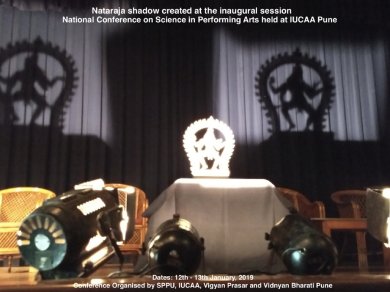
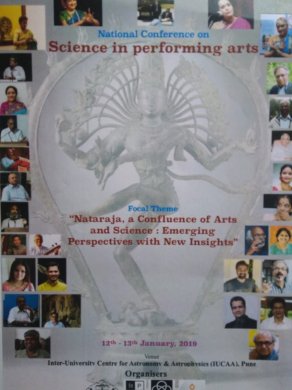 Conference on 'Science in performing arts', Pune Among dancers guru Shama Bhate opened with her paper on where Nataraja stands in dance and her group Naad-Roop rendered a short, pleasant Kathak cameo, using split stage to show Shiva Nataraja lore at various levels. Avni Gadre and Shivangi showed substance and the lone male dancer was rather marginalized. All in all, a production with potential to travel. Dr. Padma Subrahmanyam's session next (from dance segments) on karanas was most academic and properly planned, conducted and articulated. This is Madras at its best. She was supported by her ace disciple Dr. Gayatri Kannan, who demonstrated the karanas too. Dr. Sonal Mansingh's session was the power of thought and words. She is one person who can control masses and classes (audiences). Her focus was on larger social concerns and contexts and also raised an important question, which I too had brought up the day before, while moderating one of the three sessions both days. The point was: In all this talk of male energy, Shiva and Nataraja, where was Shakti? Where was Devi? How can Purush be without Prakriti? Many panelists made points but only few made an impact. Building biologist Mayank Barjatya, the architect was honest in saying how a generation of PWD-type architects had failed India by making drab buildings. The well known sculptor Balan Nambiar's time-piece, an old HMT watch, sentiment-laden, he bemoaned, was stolen from his room but he stole everyone's heart by saying art ought to be valued in society. Film maker Pankaj Saxena did some plain speaking on how Nataraja is not much understood in North India. Dr. Binay Panda amplified the gene theory while Kathak dancer Nalini (dancing duo with sister Kamalini) proved to be the hidden gem while espousing the cause and concept of sampurna nrutya yoga. Her speech had purpose and punch.  Nalini 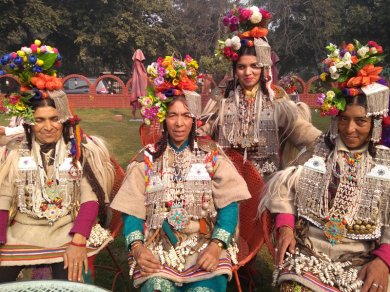 Dard Aryans from Ladakh Indologist Dr. Sharada Srinivasan's session was more akin to a classroom-in-college type session, with basic information in a power point presentation that had no power and made no new point. Then, just as one thought she was concluding after an hour of being on stage, she presented a long film sequence of herself dancing with a foreigner performer over and above the one hour already allotted; this was sheer self indulgence as we were already running late and there were 3 more sessions to go before winding up. Organizers should be firm and keep the proceedings running on planned time schedules. From Nataraja back to land of Shiva up in the Himalayas from where to IGNCA Delhi came a group of most innocent Dard Aryans from LOC (Line of Control) Ladakh. Such simplicity in their being but much richness in their costumes. 30 artistes brought all the way to Delhi for a 5 day focus on their real dard (pain) of suffering harsh climate, conversions and contexts. Seminars, dance shows, visit to JNU and Kumbh, these and more were put together lovingly by Dr. Virendra Bangroo, himself a displaced Kashmiri Pandit. Dr.Ramesh Gaur, HoD, Kala Nidhi, went out of the way to support this initiative totally, under leadership of Member Secretary, Dr. Sachchidanand Joshi. The mother of all (dance) gatherings - The Republic Day Parade in capital of India - then took over the last week of January and what a pleasant surprise it was to see in dance category Milena Salvini get the Padma Shri honor. Prabhu Deva and Narthaki Nataraj completed the trimurti. Viva la republic!  Ashish Mohan Khokar is a senior critic and historian with interest in cultural policy, international exchange and helps dance in many ways. He edits attendance and mentors many. Comments * I was present at both conferences in Baroda and Pune, both of which were wonderful experiences. Ashish ji was the moderator for all the panel discussions in Pune and kudos to him for streamlining the speakers into cohesive thought! - Sunil Sankara (Jan 29, 2019) Post your comments Please provide your name and email id when you use the Anonymous profile in the blog to post a comment. All appropriate comments posted with name & email id in the blog will also be featured in the site. |